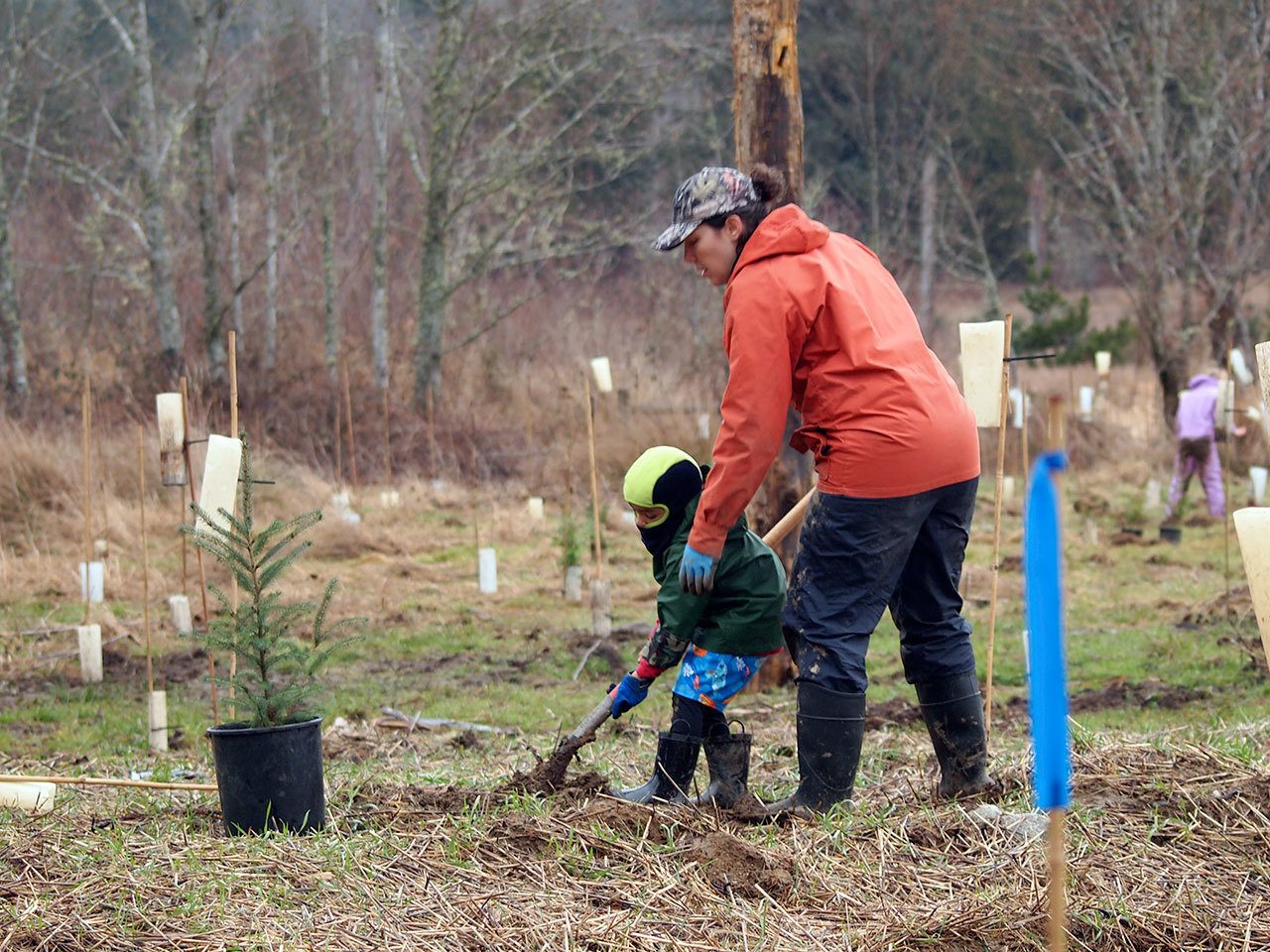PORT TOWNSEND — Volunteers planted a record 6,500 trees and shrubs in one day during the 11th Northwest Watershed Institute Plant-A-Thon at the Tarboo Wildlife Preserve.
The 140 volunteers from five East Jefferson County schools worked to restore salmon and wildlife habitat by planting 2,500 native trees and installing 4,000 live stakes of willow and other native shrubs along Tarboo Creek on Feb. 4, said Jude Rubin, director of stewardship and public involvement for the Northwest Watershed Institute (NWI).
“It is incredibly inspiring to see people of all ages, from pre-school to grandparents, working together to do something for the earth,” said Daniel Molotsky, lead elementary and middle school teacher for Port Townsend School District’s OCEAN (Opportunity, Community, Experience, Academics and Navigation) Program.
“I was heartened to hear the conversations between teens about the importance of protecting salmon habitat. People working together can make a positive impact.”
The Plant-A-Thon has become the largest environmental service project in East Jefferson County, Rubin said.
“Since 2005, more than 1,000 students, parents, teachers and friends from seven different schools have participated in Plant-A-Thon,” Rubin said.
“Over this time, volunteers have planted more than 35,500 native trees and approximately 7,000 native shrubs while earning more than $140,000 for their schools.”
Each tree is planted in honor of someone special, Rubin said. For a small fee — $5 to $10 — anyone can participate.
Each sponsor receives a Tree Card to personalize and send. All proceeds from card sales benefit the schools.
The Tree Card for this year was created by Port Townsend artist Amanda Kingsley. To sponsor trees, visit http://tinyurl.com/PDN-schoolsforplantathon.
Participating schools included Port Townsend School District’s OCEAN program, Port Townsend High School’s Students for Sustainability, Swan School and Jefferson Community School, and Chimacum High School’s Pi Program.
During the Plant-A-Thon, volunteers also tackled a half-mile of stream bank dominated by reed canary grass, laying down cardboard and staking it down with live stakes of willow and other shrubs along the creek.
Rubin said that the cardboard smothers the invasive grass until the willow has time to grow and shade it out by the second year, preventing stream bank erosion while helping to shade the stream.
Sheets Unlimited in Renton donated 8,000 pounds of new cardboard sheets to the event.
By the afternoon of the planting day, the curving stream was lined with cardboard and live stakes on both sides.
“It looks like a [Vladimirov Javacheff] Christo installation,” said volunteer Lucy Congdon-Hansen, referring to that artist’s famous large-scale artwork.
Volunteers also planted trees in hollow log rounds and planter boxes that function as nurse logs in wet areas where conifers otherwise have trouble growing. Port Townsend Paper Co. donated logs, which were milled into planters and boardwalks, and also were used as habitat logs in the creek.
The Plant-A-Thon is coordinated by NWI as part of the Tarboo Watershed Program, a long-term effort by the institute and 40 partner organizations to protect and restore salmon and wildlife habitat from the headwaters of Tarboo Creek to Tarboo-Dabob Bay, said Peter Bahls, NWI’s executive director.
According to Bahls, since 2004 more than 2,000 acres have been preserved in the watershed, and more than 600 acres have been restored through re-building and re-planting impacted streams, wetlands, and marine shorelines.
This year’s Plant-A-Thon took place at a new 11-acre acquisition within the Tarboo Wildlife Preserve, a 500-acre refuge owned and run by NWI.
The tree planting was a step in a restoration process that started last summer, when NWI’s field crew and contractors removed a large earthen dam and farm pond from the wetlands on the site.
“The spring-fed pond area is now accessible to young coho salmon for the first time in 30 years,” Bahls said.
The NWI crew also removed 5 acres of such invasive plants as blackberry, English ivy and Japanese knotweed, which, if left to grow, prevent native forests from establishing along streams,” Bahls added.
Funding for the Plant-A-Thon varies each year. The 11-acre property was acquired by NWI through a National Coastal Wetlands Conservation grant from the U.S. Fish and Wildlife Service, administered through the state Department of Ecology, Rubin said.
Restoration work was sponsored in part by the Coastal Wetlands grant and cost-share funding from the U.S. Natural Resource Conservation Service.
Funding for trees and field supplies was provided by the state Department of Fish and Wildlife’s Aquatic Lands Enhancement Program, while educational programming and staff support was provided in part by presenting sponsors Kitsap Bank, Port Townsend Food Coop and NWI.
Local businesses supporting Plant-A-Thon included SOS Printing, Henery’s Hardware, Port Townsend Paper Co., Sheets Unlimited and Goodman Sanitation.
Other businesses such as San Juan Taqueria, Pan d’Amore and Marina Café donated food. NWI, Port Townsend High School and the PTHS Students for Sustainability funded, and the OCEAN Program provided, transportation.
During the fall, months before the Plant-A-Thon event, students from 11 K-12 classes studied “How salmon grow on trees, and trees grow on salmon,” a classroom-based NWI program that teaches students about the interdependence of salmon and temperate rainforests.
A week before Plant-A-Thon, a team of 28 crew leaders — 18 high school students and 10 adult mentors — learned how to lead volunteers in planting and safety procedures.
Those interested in supporting the Plant-A-Thon and NWI’s Youth Environmental Stewards program, are asked to contact Rubin at 360-774-1457 or jude@nwwatershed.org.

